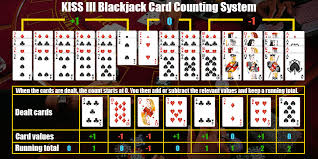
There are actually 3 different Kiss systems, with Kiss 1 being the most simple. KISS stands for Keep It Short and Simple. These systems are said to be great for beginners because they are easy to learn.
Fundamentals of the KISS systems
The most appealing part of these systems is that a running count is used instead of a true count. This means there is no heavy division necessary to keep track of the cards.
There are only 3 card values: -1, 0 or +1. Your count starts at zero and continues until there is a shuffle, when your count resets to zero.
These are classified as unbalanced systems, which means if you count down a deck, you won’t necessarily end at zero. The unbalance occurs because there is an uneven number of positive and negative valued cards. (in Kiss 1, 4 cards count as +1, only 3 cards count as -1)
As with all card counting systems, the goal of the KISS systems, is to help you know when you should increase your bets, because there is a greater chance to hit a blackjack. If the count is high, bet more, if the count is low or negative, stay at the minimum bet.
Kiss 1 System
This is the simplest of the 3 systems because you have to track the least number of cards.
The card value chart is:
| Red2/Black2 | 3 | 4 | 5 | 6 | 7 | 8 | 9 | 10 | J | Q | K | A |
| 0 /+1 | 0 | +1 | +1 | +1 | 0 | 0 | 0 | 0 | -1 | -1 | -1 | 0 |
If it is a red 2, the value is 0, if it’s a black 2, the value is +1. That may be the most difficult thing to remember.
The only cards you need to keep track of are: Black 2, 4, 5, 6, J, Q, & K. This system eliminates almost half the deck, making it easier to keep a running count.
It doesn’t matter how many decks are used, but it does work better with fewer decks.
Kiss 2 System
If you’re looking for a little more accuracy, the Kiss 2 will give you that by adding 2 more cards to keep track of, being 3’s and 10’s.
The card value chart is:
| Red2/Black2 | 3 | 4 | 5 | 6 | 7 | 8 | 9 | 10 | J | Q | K | A |
| 0 /+1 | +1 | +1 | +1 | +1 | 0 | 0 | 0 | -1 | -1 | -1 | -1 | 0 |
It remains an unbalanced counting system because you’re only tracking black 2’s.
If you are comfortable with Kiss 1, it shouldn’t be too difficult to step up to the next level of Kiss 2.
Kiss 3 System
As suspected, Kiss 3 increases the accuracy even more because it add’s 7’s and Aces to the count. A seven will add 1 to the count and an ace will subtract 1 from the count.
The card value chart is:
| Red2/Black2 | 3 | 4 | 5 | 6 | 7 | 8 | 9 | 10 | J | Q | K | A |
| 0 /+1 | +1 | +1 | +1 | +1 | +1 | 0 | 0 | -1 | -1 | -1 | -1 | -1 |
As you can see, you have to keep track of the most cards with this system, so it would be more difficult to implement, but also the most accurate.
This is the version that is best suitable for multiple deck games.
Sizing your bets
An easy rule of thumb, or suggestion, about sizing your bets with these systems is to use the running count as a multiplier of the table minimum bet.
For example, if you’re at a $5 minimum table and your card count is +3, your bet should be $15. This keeps you at a minimum bet unless the count gets to +2, where you would want to bet $10.
Using this method should keep you under the radar of any “eye in the sky” surveillance hunting for card counters, because your bet range should not have wild swings.
Final Thoughts
From the name alone, you would guess this should be an easy system for beginners to use and it is. It’s fast and simple to learn, with not much math at all. Using the Kiss system changes the house advantage by a minimum .48%, enough to make a positive difference in a good session of blackjack.
With 3 versions of the Kiss system, you as a beginner, can start at whatever level you want. You decide how serious you want your game play to be and you can decide how much of an advantage you want to create for yourself. The KISS systems are very simple, and depending on the level, can be very efficient and effective.








